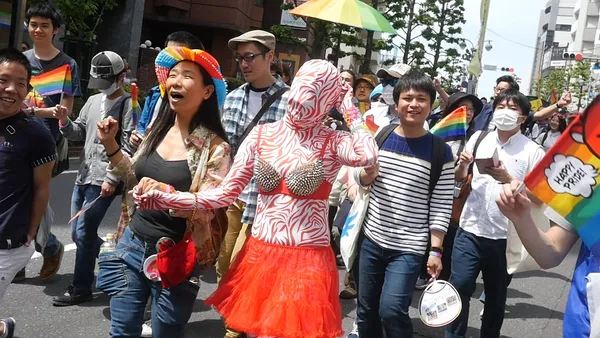 |
| Tokyo Rainbow Pride, as captured in Queer Japan |
A colourful voyage through hidden aspects of contemporary Japanese society, Graham Kolbeins’ Queer Japan takes in everything from politics to play parties, AIDS activism to art. It’s informationally dense yet continually engaging, and will be a real eye opener for most viewers. Productions like this take a lot of commitment and this film took four years of its director’s life. When we meet, I ask him what was involved in that.
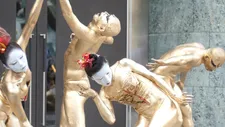 |
| Asushi Matsuda and Dairikudakan |
“It was a big undertaking,” he acknowledges. “Queer Japan is my first feature length documentary. I had a number of short documentaries before, but I had never taken on a project of this scope. And it was all independently financed through crowdfunding and a grant from the Japan-US Friendship Commission. So it really wouldn't have been able to happen without that institutional support and the funding of just normal individuals who wanted to see a film with this subject matter get made.
“As a result, I had a lot of creative freedom to explore, and along with my producers and co writer, I was able to sort of just continue filming conversations and follow where those discussions led us, sometimes in really fun and unexpected new directions, and kind of like, amass all this incredible footage and try to condense it down into a feature length format. So, you know, after we stopped shooting, there was just over 100 interviews to edit and translate and subtitle. And, you know, we tried to reach out to some bigger production companies to see if anyone wanted to take this on and help us finish post production. But it remains a very independent effort throughout. So it was kind of like, going to take as long as it took. And I'm really thankful for the patience of our cast and crew while we put it all together.”
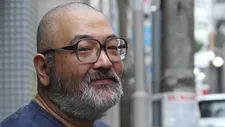 |
| Genoroh Tagame |
So was it a case of meeting people and hearing from them about other people and going to look for people that way?
“Yeah, it was really a fantastic organic structure of how the film was composed. So we started with a handful of people that we had met through the work that I had been doing with Anne Ishii, my co writer and co producer. The two of us had been working on getting gay manga artists published and translated into English. And we had been doing some tours with Gengoroh Tagame among the gay manga artists featured in the film, you can see some of the footage of us going around with him.
“And so we had a few people who we hadn't established relationships with, and we got suggestions from them on who else we should be interviewing. And some of them are like you wouldn't expect necessarily, so Gengoroh Tagame, for instance, was the one who recommended we interview Simone Fukayuki, who is a legendary drag queen from Kyoto. And yeah, it kind of just like spiralled out when we visited new cities, we would have interviews with people and then they would tell us to talk to so and so. And it just was a really fun, unexpected journey along the way.”
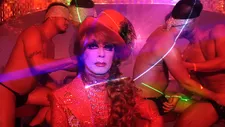 |
| Simone Fukayuki |
It has a wonderfully expansive and inclusive definition of queer with LGBT people but also BDSM people and fetish people, I note – and the idea that being queer in Japan can include having a passion for giant inflatable kaiju is fantastic. Was this something that he was expecting when the project began, that there would be so much variety in that community?
“Well, there’s Department H, which is this big party dedicated to all things hentai. And in in this usage, it [hentai] has a similar meaning to queer, just like sexuality outside of the norm. So I hadn't ever been to this party before I arrived for production on Queer Japan. And my producer, like the first day that we were shooting, Hiromi Iida was telling me like, “We have to go to Department H this weekend, you have to check it out.” So I didn't really know what to expect. And we went to that party. Informally Hiromi had shot a short documentary there before, so she had friends within the party. But I was just astounded at how incredible all these different displays of kink BDSM and just personal identity were at Department H, so I thought immediately, we have to film this party. And and that's how I got to know about the inflatable kaiju and incredible artists like Cyborg who made the big inflatable pig on stage, and that was all during their month of latex. They have different themes at that party, and we shot on latex night, which was really fun.”
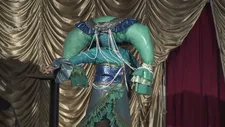 |
| Dokumurasaki Kano at Department H |
I tell him that the puppy play fascinated me as well because it’s something that has at some point come from the West and that has been translated into something that seems very distinctly Japanese.
“Yeah, it was really fun to get to hear the perspectives of people who were doing puppy play, and talking about how they had seen it online, but then they kind of put their own spin on it and came up with these incredible latex masks. And they would just get on the runway and show off. And some of them had props like a bicycle. And it was more like a runway show than some of the play environments I've seen in North America, which are more focused on kink and community. But this was taking it into a level of showmanship I hadn't seen in that world before. So that was exciting.”
It reminded me a bit of vogueing, I say, and he agrees.
“It's so cool to see a space like Department H where all these different cultures can come together and intersect. And yeah, I feel like those spaces might not exist if it hadn't been for vogueing in the United States and other forms of queer nightlife that evolved in the Eighties and Nineties.”
There’s an amazing overlap between queerness and art in the film.
 |
| Saeborg and her giant latex pigs |
“Yeah, I'm always a fan of artists. And I think that's kind of where it started for me, to work on this project. I was a fan of these gay manga artists and illustrators, and as I was visiting Tokyo to do interviews with them for print publications, I started to see all these other incredible forms of artistic expression happening in Tokyo's queer community. And yeah, I think alongside activism, art is such an essential way that queer people can express themselves in the world. We are always given a stage and a spotlight that we don’t have in mainstream society. A lot of times queer individuals have to make that space for themselves and find their own creative expression of their own voice. That may not have it any place within mainstream society. So I'm always I'm really impressed by artists who sort of push the boundaries and express their queerness through their work.”
Watching queer film festival content can be hard going, I venture, because an awful lot of films about the community are grim. It’s a pleasure to watch something that’s so much fun. That said, it does touch on political issues, and I like the interview he did with Aya Kamikawa.
“Yeah, it was such an honour to get an interview with Kamikawa. She's the first openly transgender official elected in Japan. And she was elected in the early 2000s, to a city council spot. And although that is a fairly municipal position, it gave her all of this leeway to be able to speak with politicians in the national government and advocate for the rights of trans people. And she's also been central to advocating for same sex marriage rights and just trying to create a more inclusive government in Japan.
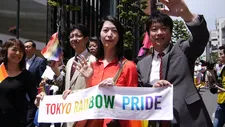 |
| Aya Kamikawa at Tokyo Rainbow Pride |
"She's an inspiration and a leader in the community. And she was also very frank about the difficult realities facing LGBTQ people in Japan, and how the legal system is set up in some ways to not acknowledge their existence or to discriminate against trans people and queer people. So I'm grateful for what you said, that this film comes across as joyful, but I wanted to make sure that we weren't ignoring the difficult realities of queer life in Japan, while at the same time celebrating the joy and beauty that can come with the queer experience.”
With that in mind, it also looks at HIV and the stigma around it that continues to be a huge problem in Japan. I tell him I found it interesting that he brought in aspects of disability culture there as well, which often intersects with queer culture. How did he go about finding people who were comfortable talking about that and getting their stories into the film?
“Yeah, so one of the main HIV advocates that we featured in the film is Hiroshi Hasegawa, who is a longtime friend of Gengoroh Tagame, and they started this seminal gay magazine, G-Men, together, in the early Nineties, It was one of the first publications that dealt with HIV and AIDS in a frank and honest way. Gay magazines, up until that point, really hadn't wanted to address that subject because they thought of it as taboo. But because of the political situation surrounding HIV AIDS, it was made necessary that that was like the rallying point for so many people to organise around in the Nineties and 2000s. And still to this day it has created this activist network of bars in the gay nightlife that may not really have had much association before, and now they are all connected.
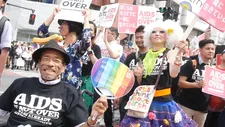 |
| Hiroshi Hasegawa at Tokyo Rainbow Pride |
“It was a privilege to be able to sit down with Hiroshi and hear his experience as one of the earliest cases of HIV AIDS in Japan. He was like the 150th person diagnosed, he mentions in the film, and that really changed his whole sense of identity and the work that he was doing to become an advocate for the rights of LGBT people and HIV positive people. So it was really a flashpoint. Around the time that Act Up was changing queer politics in North America and elsewhere, organisations parallel to that were started in Japan...it was cool to be able to connect with that, it's sort of a sense of history, but it's still going on.”.
There’s a lot of history in the film, and of course Japanese history is full of stories about LGBTQ people which were repressed after contact with the West.
“Yeah, definitely. There's so much history to explore there in terms of how the forced opening of Japan to the West at American gunpoint sort of forced this rapid modernization of Japanese society in the late 1800s. For better or worse, and a lot of the worst comes from these Western values of things that are civilised and uncivilised, which really seeped into the Japanese consciousness in the following decades. So, although expressions of queerness and trans identity had been very normalised and not stigmatised in the Edo period, basically from the 1500s to the 1800s, you see so much literature and artistic depictions of queer sexuality and non normative gender identity in various ways. So to see that all get swept under the rug, it's kind of saddening that it happens directly after the Meiji Restoration in the mid 1800s. And that's all part of a journey.
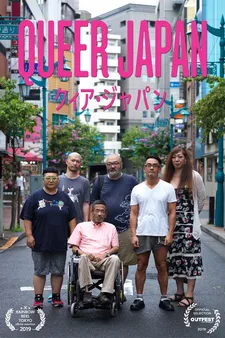 |
| Queer Japan poster |
“There's so much history there, and I feel like in the last half century, Japan has been sort of reclaiming its own queer identity, or finding new routes back to those depictions of queerness in the past. And that's something that's touched on a little bit in the film. But I feel like there needs to be an entire documentary about historical Japanese queerness. And and I don't necessarily know that I'm the one to make it. I've read a couple of books on the subject matter. But I really wanted this film to focus on what's happening right now, like what does contemporary queerness look like in Japan.”
It seems to be a snapshot that will be useful to people in the future, looking back on where we're at at this point.
“Yeah, I'm really glad we could capture this moment in time. And I hope that even though it's coming out right now in the middle of a worldwide pandemic, I hope it gives people some inspiration and joy and, and helps them remember what it was like when we could all get together and go to fun parties.”
He’s spending his time in lockdown working on a screenplay, he tells me. After spending years making a documentary, he wants to try his hand at fiction, exploring science fiction and the near future.
























